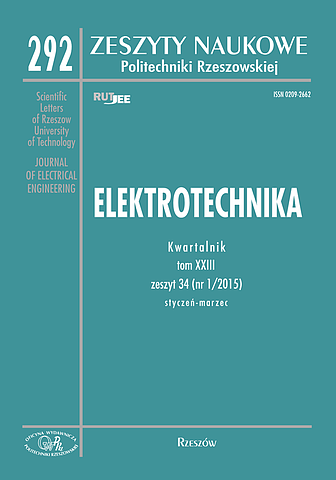Abstract
The paper is devoted to the issue of the accuracy of biomedical experiments where electromagnetic fields are used. Selected sources of uncertainty were presented. One of them is mutual interactions between tested objects placed in exposure system. The paper proposes a solution to eliminate this phenomenon. It is the device for exposure of biological objects in the form of dielectric cage. Another source of uncertainty that is discussed in this work is the use of electromagnetic field with linear polarization only. In laboratory studies of bioeffects caused by an exposure to electromagnetic field performed in vivo usually linear polarized fields are in use. In order to have a possibility to quite accurate estimate the absorbed energy usually an animal under test is kept non-moving, that may lead to a stress that may cause effects exceeding that of the resulted by the exposure. In the case of the animal free behavior in the exposure system the quantity of absorbed energy is a function of animal position in relation to the field vectors and, as a result, in the case calculations of the absorbed energy quantity is loaded with remarkable error. To prevent this a new solution was proposed. It is an exposure system that would allow to expose animals that may move freely during the exposure. A quasispherical exposure system for this purpose is proposed. The study used numerical methods that enabled the efficient computer simulations. Analyzed issues are referred to the current research.
References
[2] Długosz T.: A new solution for biomedical experiments, Electromagnetic Biology and Medicine, Vol. 33, Issue 3, 2014, s. 236-240.
[3] Długosz T.: Problemy w ekspozycji obiektów biologicznych na pole elektromagnetyczne, Przegląd Telekomunikacyjny i Wiadomości Telekomunikacyjne, R. 82, nr 6, 2009, s. 601-603.
[4] Długosz T.: Wzajemne oddziaływanie linii transmisyjnej TEM i badanego w niej obiektu, rozprawa doktorska, raport Instytutu Telekomunikacji, Teleinformatyki i Akustyki Politechniki Wrocławskiej, seria I28/07/P-004, Wrocław 2007.
[5] Długosz T., Trzaska H.: A new calibration method for non-stationary electromagnetic fields measurements, Journal of Electromagnetic Waves and Applications, vol. 23, nr 17-18, 2009, s. 2471-2480.
[6] Długosz T., Trzaska H.: Mutual interactions in bioelectromagnetics, Environmentalist, vol. 27, nr 4, 2007, s. 403-409.
[7] Dlugosz T., Trzaska H.: Polarization Problems in Bioelectromagnetic Experiments, 7th International Workshop on Biological Effects of Electromagnetic Fields, Malta, October 8-12, 2012, CD Proceedings, ss. 1-7
[8] Długosz T., Trzaska H.: Pomiary PEM w polu bliskim a dalekim, Przegląd Telekomunikacyjny i Wiadomości Telekomunikacyjne, R. 79, nr 8-9, 2006, s. 251-253.
[9] Długosz T., Trzaska H.: Proximity effects in the near-field EMF metrology, IEEE Transactions on Instrumentation and Measurement, vol. 57, nr 11, 2008, s. 626-630.
[10] Długosz T., Trzaska H.: Sposób ekspozycji na pole elektromagnetyczne obiektów materialnych, zwłaszcza biologicznych i urządzenie do ekspozycji na pole elektromagnetyczne obiektów materialnych, zwłaszcza biologicznych, patent nr 215545, zgłoszenie patentowe nr P 385094 z 05.05.2008, opublikowano 31.12.2013.
[11] Duan W., Liu C., Wu H., Chen C., Zhang T., Gao P., Luo X., Yu Z., Zhou Z.: Effects of Exposure to Extremly Low Frequency Magnetic Fields on Spermatogenesis in Adult Rats, Bioelectromagnetics Vol. 35, Issue 1, 2014, s. 58-69.
[12] Faraone A, Luengas W, Chebrolu S, Ballen M, Bit-Babik G, Gessner AV, Kanda MY, Babij T, Swicord ML, Chou CK.: Radiofrequency dosimetry for the Ferris-wheel mouse exposure system, Radiation Research, vol. 165, issue 1., 2006, s. 105-112
[13] Kim H.S., Paik M.-J., Kim Y.J., Lee G., Lee Y.-S., Choi H.-D., Kim B.C., Pack J.- K., Kim N., Ahn Y.H.: Effects of Whole Body Exposure to 915 MHz RFID on Secretory Functions of the Thyroid System in Rats., Bioelectromagnetics, Vol. 34, Issue 7, 2013, s. 521-529.
[14] Kleijn S., Trentelman J., Arts J, Cuppen J, De Jager L., Ferwerda G, Hermans P., . Verburg-van Kemenade L.: Extremely low frequency electromagnetic field exposure modulates stress regulation in mice, 33rd Annual Meeting of The Bioelectromagnetics Society, 12-17 June, 2011, http://www.bems.org
[15] Li C., Chen Z., Yang L., Lv B., Liu J., Varsier N., Hadjem A., Wiart J., Xie Y., Ma L., Wu T.: Generation of Infant Anatomical Models for Evaluating Electromagnetic Field Exposures, Bioelectromagnetics, vol. 36, issue 1, 2015, s.10-26.
[16] Liang S., Xu J., Ding J., Huo Y.: Experimental investigation of the antenna layout in source stirring reverberation chamber, Electromagnetic Compatibility (APEMC), 2010 Asia-Pacific Symposium on, s: 582 – 585.
[17] Rostamzadeh C., Archambeault B., Connor S.: FDTD analysis of symmetric TEM cell, Electromagnetic Compatibility, 2005. EMC 2005. 2005 International Symposium on,Vol. 2 Volume: 2, 8-12 Aug. 2005, s. 525 - 529
[18] Shirai T., Imai N., Wang J., Takahashi S., Kawabe M., Wake K., Kawai H., Watanabe S.-I., Furukawa F., Fujiwara O.: Multigenerational Effects of Whole Body Exposure to 2.14 GHz W-CDMA Cellular Phone Signals on Brain Function in Rats, Bioelectromagnetics, Vol. 35, Issue 7, 2014, s. 497-511.
[19] Shuanggang L., Jiadong X., Jianjin D., Yanning H.: Experimental investigation of the antenna layout in source stirring reverberation chamber, Asia-Pacific Symposium on Electromagnetic Compatiblity (APEMC), 12-16 April, 2010, s. 582-585.





